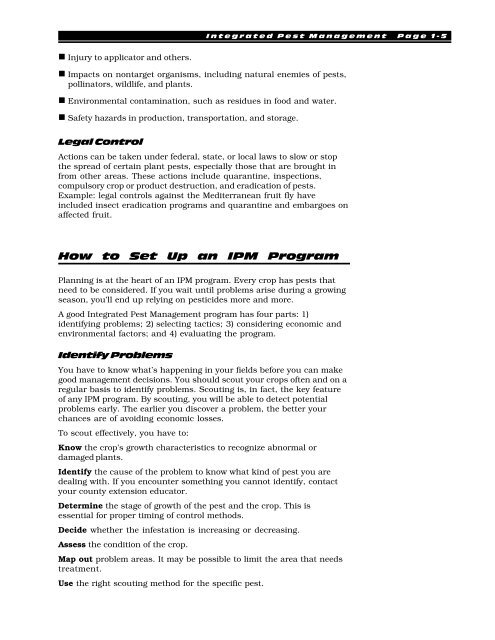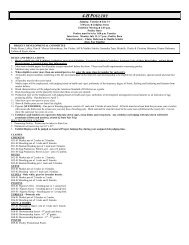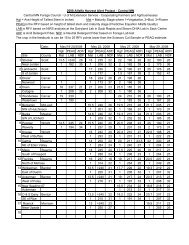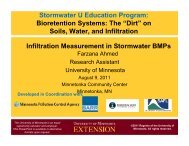Private Pesticide Applicator's Training Manual - University of ...
Private Pesticide Applicator's Training Manual - University of ...
Private Pesticide Applicator's Training Manual - University of ...
You also want an ePaper? Increase the reach of your titles
YUMPU automatically turns print PDFs into web optimized ePapers that Google loves.
n Injury to applicator and others.<br />
Integrated Pest Management Page 1-5<br />
n Impacts on nontarget organisms, including natural enemies <strong>of</strong> pests,<br />
pollinators, wildlife, and plants.<br />
n Environmental contamination, such as residues in food and water.<br />
n Safety hazards in production, transportation, and storage.<br />
Legal Control<br />
Actions can be taken under federal, state, or local laws to slow or stop<br />
the spread <strong>of</strong> certain plant pests, especially those that are brought in<br />
from other areas. These actions include quarantine, inspections,<br />
compulsory crop or product destruction, and eradication <strong>of</strong> pests.<br />
Example: legal controls against the Mediterranean fruit fly have<br />
included insect eradication programs and quarantine and embargoes on<br />
affected fruit.<br />
How to Set Up an IPM Program<br />
Planning is at the heart <strong>of</strong> an IPM program. Every crop has pests that<br />
need to be considered. If you wait until problems arise during a growing<br />
season, you’ll end up relying on pesticides more and more.<br />
A good Integrated Pest Management program has four parts: 1)<br />
identifying problems; 2) selecting tactics; 3) considering economic and<br />
environmental factors; and 4) evaluating the program.<br />
Identify Problems<br />
You have to know what’s happening in your fields before you can make<br />
good management decisions. You should scout your crops <strong>of</strong>ten and on a<br />
regular basis to identify problems. Scouting is, in fact, the key feature<br />
<strong>of</strong> any IPM program. By scouting, you will be able to detect potential<br />
problems early. The earlier you discover a problem, the better your<br />
chances are <strong>of</strong> avoiding economic losses.<br />
To scout effectively, you have to:<br />
Know the crop’s growth characteristics to recognize abnormal or<br />
damaged plants.<br />
Identify the cause <strong>of</strong> the problem to know what kind <strong>of</strong> pest you are<br />
dealing with. If you encounter something you cannot identify, contact<br />
your county extension educator.<br />
Determine the stage <strong>of</strong> growth <strong>of</strong> the pest and the crop. This is<br />
essential for proper timing <strong>of</strong> control methods.<br />
Decide whether the infestation is increasing or decreasing.<br />
Assess the condition <strong>of</strong> the crop.<br />
Map out problem areas. It may be possible to limit the area that needs<br />
treatment.<br />
Use the right scouting method for the specific pest.

















